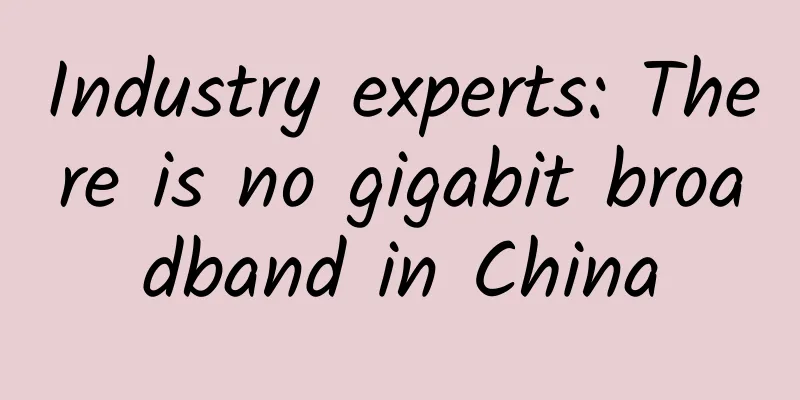Industry experts: There is no gigabit broadband in China

|
The broadband market has been jaw-dropping recently, with some small broadband providers announcing that they will launch gigabit broadband. However, industry insiders questioned that if first-tier broadband providers such as China Unicom and China Telecom have not yet launched gigabit broadband, how can other companies do so? The basis for the small broadband providers' deception is actually fiber to the building, but fiber to the building means that many users share gigabit broadband, which is completely different from fiber to the home. The actual speed of gigabit fiber to the building may not even be as fast as fiber to the home at 10 to 20 megabits. Fiber to the building means that users in the entire building share bandwidth Some small broadband providers have already started to deceive people. Even though there are no products yet, banners for gigabit broadband have been hung in some communities. It seems that overnight, when most netizens have not yet used 100M broadband, the world has entered the gigabit era. However, after consultation, it was found that these small broadband providers do not actually provide the so-called gigabit broadband services, and the broadband they reported is still 10M, 30M, 50M, etc. China Telecom and China Unicom have never announced that they will launch gigabit broadband. Do these small broadband providers have the ability to launch gigabit broadband? Some industry insiders speculate that even if gigabit broadband is available, it may be fiber-to-the-building. The reason is very simple. If bandwidth is compared to a highway, the second-tier and third-tier operators are just one or two lanes. Once there are many cars, the traffic will be very slow, while the first-tier operators are the highways that are constantly being expanded. Since the second-tier and third-tier operators are shared, they will be greatly affected by the "heavy traffic". For example, if a community has built a gigabit broadband, if there is only one household, then he will use the gigabit broadband. If there are 100 households, then each person will use 10M broadband. However, a community often does not have so few people. If thousands of households share the gigabit bandwidth, then each person will use less than 1M. From the endless fake broadband incidents in recent years, many netizens have learned that the first-tier operators, such as China Unicom and China Telecom, are involved in the construction of the basic network, and their speeds generally meet the standards; while some small operators rent and purchase bandwidth from the first-tier operators, and their speeds often cannot reach the contracted speeds. One of the criteria for judging authenticity is whether there is optical fiber and optical modem Of course, we cannot "wishfully" think that the gigabit broadband launched by these second- and third-tier operators is shared broadband. However, there is an objective standard in front of us, which is the use of optical fiber. Simply put, it is whether there is an optical modem device in the house. If a regular optical fiber is converted, the operator will provide users with an optical modem device for optical fiber access, but fake optical fiber broadband does not provide it. According to the survey, in Beijing, except for the users of the first-tier operators who switched to optical fiber, the users of the second-tier and third-tier operators all use copper cables. There is a huge difference between the two. The Internet is like driving a car. If you want a fast speed, the road must be good. The copper cables we use to pursue high Internet speeds are like driving a Ferrari on a dirt road. It is really difficult. Optical fiber is the most suitable material for building the information highway. Optical fiber is a light transmission tool that uses the principle of total reflection of light in fibers made of glass or plastic. Cables are the thick black lines we see every day, with countless wires tangled together. From the outside, optical fiber is much thinner than cables; compared to the telephone lines at home, there is little difference in thickness. Since cables are transmitted in metal media, they require a lot of consumption in terms of distance and speed, which can be seen from the difference in our daily Internet speed charges. For optical fiber, there is no pressure to increase the speed, and the use of optical signals in transmission makes the loss very low. In addition, optical fiber is not affected by electromagnetic interference. According to industry expert Mr. Cheng, the bandwidth of copper cables in laboratory conditions can reach up to 40M, while the bandwidth of optical fibers under experimental conditions has almost no upper limit. So if your home is still using copper cables to access the Internet, the maximum speed can only reach 40M. This is determined by the physical properties of the two and is real and irrefutable evidence. Of course, 40M is almost impossible to achieve. The bandwidth of copper cables will decrease as the length increases. If you have paid attention to the rates of some first-tier operators, you will find that copper cables can only support up to 8M, usually only 4M. 8M requires your home address to be very close to the operator's router. It is reported that some second- and third-tier operators can achieve fiber to the building, and the switch in the building is connected to the home via copper cable. Even so, no matter how short the distance is and how large the bandwidth provided by the operator is, your home bandwidth cannot reach 100M, let alone 1G. Therefore, the 100M products launched by second- and third-tier operators in the past two years are actually fake products. If you test the speed, they will not meet the standard. Gigabit broadband is still in the conceptual stage Industry experts say that currently, it is impossible for them to produce real gigabit broadband products. According to the Ministry of Industry and Information Technology, gigabit broadband means "the information transmission rate on the link from the broadband service access point BRAS of the broadband access service provider to the user terminal reaches gigabit". This concept is very clear. Gigabit broadband can only be called gigabit and a qualified product as long as it reaches the household, even the user's computer or mobile phone. In fact, whether we care about the Internet or not, we rarely hear about Gigabit broadband in daily news. As for Gigabit broadband itself, it is still in the concept stage and there is no clear statement. There is a saying that Gigabit broadband can download a high-definition movie in about the same time as posting a Weibo, and downloading a song is probably before the computer can react. This idea was first proposed by Google, and it only lasted for a project in 2012. Recently, the concept of gigabit broadband has also appeared in China, but it is still only in the conceptual stage. It took nearly five years for my country to increase the bandwidth from 512kbps to 2mbps, a four-fold increase. Gigabit broadband is also a new concept in the industry and has not yet entered the practical stage. It is still unknown when it will be popularized in the future. Broadband false advertising frequently occurs Therefore, industry experts remind consumers not to be deceived by these pseudo-concepts. Some things that sound "high-end" have not yet come to us, such as genetic beauty, nanomedicine and gigabit broadband. The network security risks of small and medium-sized operators are also worrying: In fact, it is not just the speed and price that deceive consumers. Compared with first-tier operators, some small and medium-sized operators also have security risks. A user once revealed that when he used his home network to download file A, he always downloaded file B. This problem never occurred on the company network. He tried to change DNS and other methods but it didn't work. He suspected that the operator irresponsibly cached files on the intranet server without necessary verification, in order to achieve the purpose of increasing the speed of downloading popular files. In addition, the usual method used by small and medium-sized operators to save costs is to pull long-distance lines. For example, users in Beijing often show Baoding, Handan and other places on their QQ, and sometimes they are still changing places. Nowadays, software will check for login anomalies. The anomalies caused by the frequent IP changes of small and medium-sized operators can easily cause losses to users. At the least, the account will be suspended, and at worst, the online bank will even be stolen. As a winner of Toutiao's Qingyun Plan and Baijiahao's Bai+ Plan, the 2019 Baidu Digital Author of the Year, the Baijiahao's Most Popular Author in the Technology Field, the 2019 Sogou Technology and Culture Author, and the 2021 Baijiahao Quarterly Influential Creator, he has won many awards, including the 2013 Sohu Best Industry Media Person, the 2015 China New Media Entrepreneurship Competition Beijing Third Place, the 2015 Guangmang Experience Award, the 2015 China New Media Entrepreneurship Competition Finals Third Place, and the 2018 Baidu Dynamic Annual Powerful Celebrity. |
Recommend
Full of tricks? Exploring the meaning behind iPhone "X"
Although the world predicts that Apple will relea...
Insiders revealed that Tesla is developing a new battery pack with a maximum range of 640 kilometers
Due to the objective reality of battery capacity,...
Tesla to make biggest product transformation in history to capture Chinese users
When in Rome, do as the Romans do is a tradition ...
2 major directions + 5 capabilities + 7 strategies, SEM promotion effect is doubled!
Introduction: The promotion effect is abnormal, t...
I heard that aspirin can prevent cardiovascular disease! It's time to get to know it again...
Author: Zhang Chengjuan, pharmacist of the Drug A...
@All college entrance examination candidates, please keep this "Post-Exam Anti-Fraud Guide"
Recently, college entrance examination results ha...
Have you watched "Fang Hua"? Yes! I'm hungry after watching it! | Micro-diet therapy
Author: Fluent The most discussed and popular TV ...
APP user operations: attract new users, promote activation, and gain return traffic!
I have shared many times how to develop the mobil...
"Learn advanced science and technology so that I can return and serve my country." | Time Letter
In 1937, Qian Sanqiang went to the University of ...
Financial APP, how to open source for users
Today, the financial APP market has reached a rel...
"Food Safety Guide" Series | Chinese medicine says tea, are you drinking it right?
When I was a kid, I only heard of two kinds of te...
What technological forces are behind the successful return of Shenzhou-14?
At 20:09 on December 4, the return capsule of the...
Why do some people get diarrhea when they eat spicy food, get nervous, or catch a cold? The mystery that has lasted for many years has finally been solved
Expert of this article: Wang Xiaohuan, Doctor of ...
Don't be afraid of radiation! It turns out that it has these functions...
Grain Full, the eighth of the 24 solar terms, sym...
Why is there a saying that "cold urine and hot farts"? A little physiological secret from the perspective of biomechanics
1. Introduction "Cold urine, hot farts, poor...









